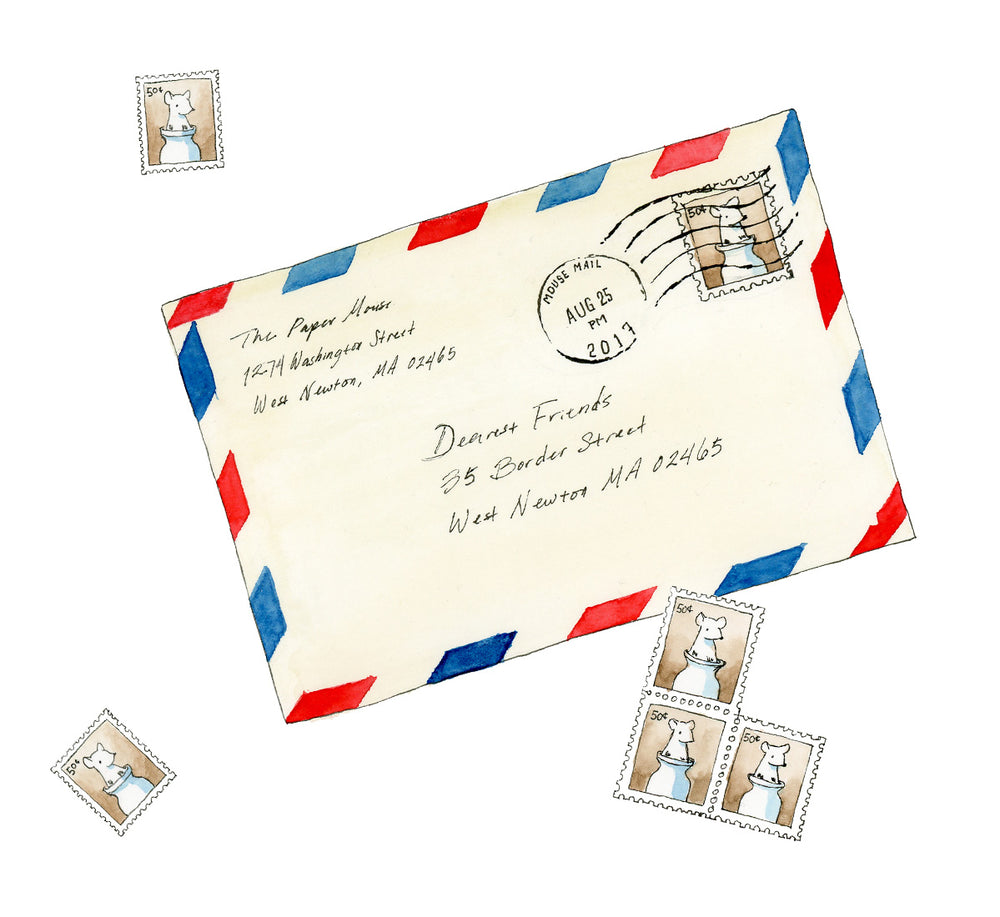Letter Writing All Year Round

Back in 2001, the USPS designated the month of April National Letter Writing Month. The Paper Mouse team loves to celebrate this snail mail jubilee, and we encourage everyone to join in the fun of writing and receiving letters this month.
It’s telling that we have a month dedicated to the art of letter writing when it was once a primary form of communication, used to share news, arrange business, and keep in touch. New technologies have dramatically changed the landscape of communication, and that’s not always a bad thing! Writing a letter with pen and paper to arrange a time and place to meet certainly doesn’t have the convenience of an email or a text message. But for all that, we’re not yet willing to relegate the letter to history. The written word has a lasting power that digital technology cannot replace. Perhaps we don’t need to conduct business via letter anymore, but to congratulate or sympathize, to share ideas with a friend, to keep in touch at a distance, a physical letter aids us by providing a deeper sense of connection.
If you enjoyed this feeling during Letter Writing Month, remember that letter writing doesn’t have to be confined to the month of April! Here are some ideas for making letter writing a part of your life year round.
Start with occasions
One of the easiest ways to incorporate letter writing into your daily life is to send a handwritten card when there’s an external reason: birthday wishes, thank yous, congratulations, or expressions of sympathy. You may be accustomed to writing these types of notes already, particularly to your closest friends and loved ones. To build a letter writing habit, try extending this familiar type of writing to a wider circle of friends and acquaintances. It takes a little bit of extra care and attention to mark a special occasion with a note, and though this was once considered matter-of-course, it’s less common these days. If sending such notes is less common, then so is receiving them, and a physical card or note can feel deeply touching for the recipient.
To expand on this practice, we can also create opportunities to write by thinking a little abstractly about what occasions are worthy of a note. Did a friend buy a new car recently? Send them a note to wish them safe travels. Did they lose or break something with sentimental value? Send a sympathy note to console them. You can send a card for reasons serious, silly, or tongue-in-cheek, but no matter the occasion, you are witnessing and acknowledging an event in your friend’s life, something which is nearly always appreciated.
Find a pen pal
If you’re looking for a more in-depth correspondence, it’s time to find a pen pal! You can join a pen pal exchange (see this farewell post from the Letter Writers Alliance for some great options), or mention your interest to friends and acquaintances to see if anyone shares your enthusiasm for letter writing. If they don’t and you’d rather not write to a stranger, you can still write letters. Make a list of friends and family to write to, and go through your whole list before returning to the first recipient. That way, you’ll get to write plenty of letters without pressuring anybody to write back. Even if your friends don’t love to write, they’ll still love hearing from you - and who knows, maybe you’ll inspire someone to give it a try!
If you do start writing to a pen pal, remember to start small and grow your correspondence over time. It can be tempting to meet a whole crowd of pen pals at once, but remember that writing letters takes time. In the initial rush of enthusiasm, it can be easy to overcommit to several people and become overwhelmed out by the commitment. You can always add more later!
Keep a letter log
Unlike emails, handwritten letters don’t get saved in your “Sent” mailbox. If you’ve ever received a reply to a letter only to find that you don’t remember what you first wrote about, a letter log may come in handy. This can be anything from a small notebook where you jot a few notes about the date of your letter, who you wrote to, and the topics you touched on, to a draft, scan, or picture of the letter you wrote (modern technology does make some things easier!).
A log can be a place to note physical details of your letter as well: items included in a care package, for example, or what kind of stationery you used. Not only is it a helpful aid to memory that fills in half of your conversation, but it can be a nice keepsake to look back on later, reminding you of how many people you’ve reached out to.



I’m having a grand time participating in a national event. I am 69 years old, I’ve been writing letters since I was a young girl. I have many letter writing stories and memories and some letter treasures. For example, i have letters from my dad when he was stationed in Korea and Vietnam. He died in Vietnam when I was 13. I am writing an epistolary middle grade historical fiction book based on that event.
I have my letter from the author Walter Farley, who wrote The Black Stallion.
This year two of my grandsons are participating with me in National Letter writing month. They are 12 and 14. We did some fun preparation. I gave them new fountain pens, plenty of stationary and a variety of stamps. They have their own personalized return address labels. We spent sometime talking about who they would write to. I am super proud of their diligence and thoughtfulness.
Thank you for encouraging letter writing and letting me share some of my story.
Leave a comment